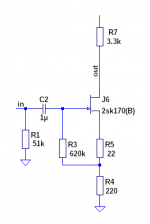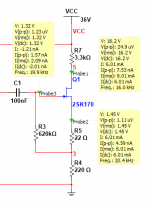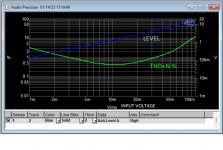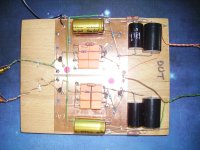Yeah you are probably right.I have to regretfully report that (and with all due respects) there is no configuration of LePacific which will prevent clipping with the high output cartridge.
However, there is improvement. Gain has been lowered but clipping has visibly subsided.
Capturing the same tracking test in Audacity before, resulted in visibly worse outcome.
But, without more detailed measurements there is no way (for me) to analyse what exactly is going on.
Regarding alternatives that could possibly handle 10mV pickups without much alterations:
Apart from Pearl II which i've considered in the past but is a bit more complicated, what do you think of say RJM's CrystalFet 2?
Here is the latest (i think) schematic of its MM only, lower-gain version:
Would it be more capable, with adjustment maybe, to keep up better?
there is no configuration of LePacific which will prevent clipping with the high output cartridge.
As someone who tinkered a LOT with different variants of the LePacific circuit I am sure there is a configuration that won't clip even with a 10mV cartridge. But insufficient overload margins are a common problem for phono stages with passive RIAA filters, especially when low rail voltages are used. That's a clear advantage of the "CrystalFET" circuit, where 35V are applied. I know there are variants of the LePacific with higher rail voltages, have a look at the development thread of @Salas "simplistic NJFet RIAA".
As someone noticed before, I am not a math or theory crack able to proof my point with two formulas.
This is the OP circuit without the passive RIAA network, to illustrate gain compression.
I am not sure if it really helps to calculate the overload margin of a phono stage without the effects of 0dB - 20dB - 40dB damping of the RIAA Filter at 10Hz - 1kHz - 20 kHz.
and the cartridge output is the inverse of the RIAA network.I am not sure if it really helps to calculate the overload margin of a phono stage without the effects of 0dB - 20dB - 40dB damping of the RIAA Filter at 10Hz - 1kHz - 20 kHz.
A closed thread dealing with over-head margin: https://www.diyaudio.com/community/...oom-not-as-hard-as-goedel-escher-bach.325700/
Instead of using a large electrolytics in the source, it is better to use a small film capacitor at the gate. And overloading need not to be a problem...The drain current is set by R5, and the gain is set by R4 and R7 in combination with the transconductance of the JFET.
Attachments
Indeed, will have to build it in a few minutes, but simulation seems to indicate that you can hold distortion quite low with this "level shifting" arrangement!Instead of using a large electrolytics in the source, it is better to use a small film capacitor at the gate. And overloading need not to be a problem...The drain current is set by R5, and the gain is set by R4 and R7 in combination with the transconductance of the JFET.
Attachments
Sorry.. but this seems an Incredible and never ending Saga.
All this to try to use an old and IMO fairly crap even when Brand New...in 1970!
Unloved even then... OEM fitted to the bottom feeder stereos of the era.
Splurge the few $ for even the cheapest Cartridge mfg'd in This century.
Problem is NOT the Le pacific.
All this to try to use an old and IMO fairly crap even when Brand New...in 1970!
Unloved even then... OEM fitted to the bottom feeder stereos of the era.
Splurge the few $ for even the cheapest Cartridge mfg'd in This century.
Problem is NOT the Le pacific.
Look to the graph in post 55, the poor gain compression is a problem, even with a more typical cartridge.Problem is NOT the Le pacific.
Knutn has provided a simple and elegant solution.
Next, take a listen.
I don't know if it's entirely "gilding the lilly" but Klaus suggests cascode -- this is very easily accomplished with OnSemi's CPH3905 BJT/FET surface mount device. The JFET in the CPH3905 is very similar to that of the 2SK369: http://www.klaus-boening.de/le pacific.htm
Le Pacific's basic scheme has been heavily lobbied . . There were companies that used this scheme in their serial products . And they sold these products expensively ( for example , Jasmine ) . It 's a mystery to me how they managed to lead everyone by the nose for so long 🙁... And a lot of people took the bait , and began to repeat the Pacific scheme ......I also use a phono preamp on JFET, but it is more complicated than the Le Pacific circuit - it has 6 transistors in each channel.
The purpose of this post was to help evonimos solve a problem, which collectively we have done. Not to redesign the whole circuit or suggest he would be better off with alternatives. Its like the tourist who asked the country bumkin for directions to his destination and received the reply "if I were going that way I wouldn't be starting from here". Progress is working with what you have and finding the solution
Shure M44-7 is indeed an ancient design (same applies to endless other stuff still in use).All this to try to use an old and IMO fairly crap even when Brand New...in 1970!
Unloved even then... OEM fitted to the bottom feeder stereos of the era.
But you are a bit unfair in my opinion.
The DJ crowd loves it and that might be the reason it has a bad rep for hi-fi use.
However, that doesn't mean it sounds bad.
Apart from the DJ crowd, people still use it to listen to music (i'm one of them).
Evidently the Japanese must be fond of it too.
A testament to that, is JICO's decision to revive it.
Shure actually discontinued all its phono line back in 2018.
However, due to 'popular demand' JICO picked up the pieces and now produces this cartridge from scratch.
It's been relabelled JICO J44A 7.
Identical to the original but with a 'nude' versus a bonded tip.
Apart from that, it offers some really nice, 'exotic' versions.
For example the hand-crafted, wood cantilever J50 Ushikoroshi variant.
I'd love to hear one of those, but haven't had the chance yet.
Le Pacific's basic scheme has been heavily lobbied . .
Yes that's true. And it is perfectly suitable to fool noobs like me. When I was thinking about building a phono stage I found hundreds of designs and I was overwhelmed (because of my lack of knowledge). Then I found a kit from guy called Boozehound Labs and he was bragging that he achieved great performance from this simple LePacific circuit by using russian PIO capacitors and Dale RN60D resistors.. Now this kits are not available anymore, but they have sold like sliced bread back then.
The LePacific schematic looks pretty simple and I guess that's why many think it would be a great first project, besides the B1 buffer / volume control. And I also think that the myth of the unobtainable 2sk170 makes it an interesting story, because it makes you f
To me it was the chance to learn some basics about electronics. And after adding a capacitance multiplier to clean the rail voltage and adding a simple output buffer I really like the sound of my several LePacific iterations. But to be fair I use them with 3mV - 5mV MMs not with Sure M44-7
A recent update:
Got my hands on some genuine 2SK170BL (matched quad i got from punkydawgs) to replace my knockoffs.
Did some comparative auditioning today and i can attest to their superior performance.
Better clarity, improved soundstage, sharper imaging accuracy and bass definition.
All in all, i'm pretty happy with them.
It was definitely worth the hunt.
Got my hands on some genuine 2SK170BL (matched quad i got from punkydawgs) to replace my knockoffs.
Did some comparative auditioning today and i can attest to their superior performance.
Better clarity, improved soundstage, sharper imaging accuracy and bass definition.
All in all, i'm pretty happy with them.
It was definitely worth the hunt.
Hi again.
I've been using Le Pacific succesfully with high output Shure M44/55 for a while now and it is working nicely. Mostly a Shure M55 with a Morita Kurogaki (wood) stylus.
And the last week i've also been running tests with Jico J44A-7 DJ (nude tip) which is even higher output. So far so good, it all holds very well. No distortions, no overloading and generally i'm very happy with such a barebones RIAA.
Recent version of the dual-mono PCB (one of first truly own design-so be kind!):
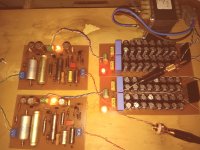
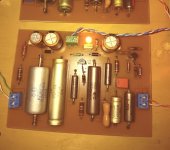
To my ears, it surpasses my other main passive RIAA stage, an Audio Note L3 clone with M2 regulated tube PSU.
My question is, since i also have several much lower output cartridges, what would be a possible way to increase gain slightly in this guy?
*Will follow with the actual version of the modified schematic used right now with the Shure.
I've been using Le Pacific succesfully with high output Shure M44/55 for a while now and it is working nicely. Mostly a Shure M55 with a Morita Kurogaki (wood) stylus.
And the last week i've also been running tests with Jico J44A-7 DJ (nude tip) which is even higher output. So far so good, it all holds very well. No distortions, no overloading and generally i'm very happy with such a barebones RIAA.
Recent version of the dual-mono PCB (one of first truly own design-so be kind!):


To my ears, it surpasses my other main passive RIAA stage, an Audio Note L3 clone with M2 regulated tube PSU.
My question is, since i also have several much lower output cartridges, what would be a possible way to increase gain slightly in this guy?
*Will follow with the actual version of the modified schematic used right now with the Shure.
Last edited:
Here is the schematic:

Any possible suggestions to increase the gain a bit, would be appreciated.
Any possible suggestions to increase the gain a bit, would be appreciated.
Thanks a lot.
Might prepare a second, higher gain variant for lower output cartridges.
Generally it's a noise-free preamp.
However, when i used two separate PSU boards to power each channel (each mono board) I encountered increased mains hum noise (60Hz /120Hz).
Tried some stuff but didn't help. Star point earthing, floating the earth with a resistor//capacitor, disconnected earth. There was no difference whatsoever.
However, connecting the two mono boards to a single PSU board, i could get it back to being noise-free.
By the way, I'm using a single transformer to power the PSU boards.
Maybe two separate transformers will help a bit?
Might prepare a second, higher gain variant for lower output cartridges.
Generally it's a noise-free preamp.
However, when i used two separate PSU boards to power each channel (each mono board) I encountered increased mains hum noise (60Hz /120Hz).
Tried some stuff but didn't help. Star point earthing, floating the earth with a resistor//capacitor, disconnected earth. There was no difference whatsoever.
However, connecting the two mono boards to a single PSU board, i could get it back to being noise-free.
By the way, I'm using a single transformer to power the PSU boards.
Maybe two separate transformers will help a bit?
Why? the constant confusion? Built this Years ago from Madds simple Le Pacific schematic Used Quality parts and Matched fets .
A v simple build that has proven DEAD silent and One of the best Phono stages I've ever heard.
Consequently I have not fooled with it for ~20 years.
As reference I Diy built my first Turntable in 1968.
Don't Overthink and DO realise that Vinyl Lps ....deteriorate... with Each playback .
Something that No -one ever, ever mentions.. these days.
LP sound quality is a moving target.
 schematic
schematic
A v simple build that has proven DEAD silent and One of the best Phono stages I've ever heard.
Consequently I have not fooled with it for ~20 years.
As reference I Diy built my first Turntable in 1968.
Don't Overthink and DO realise that Vinyl Lps ....deteriorate... with Each playback .
Something that No -one ever, ever mentions.. these days.
LP sound quality is a moving target.
Attachments
- Home
- Source & Line
- Analogue Source
- 2SK170 phono pre (Le Pacific) gets overloaded
